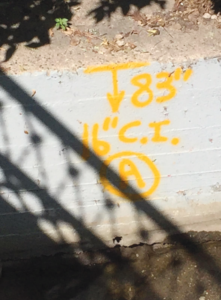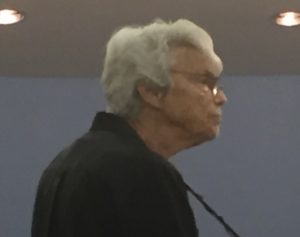At its meeting July 25, the Park Board finally responded to a question from its Lake Hiawatha Community Advisory Committee. The CAC asked whether future plans for Hiawatha could include an 18-hole golf course. The Board answered: “The Board of Commissioners intends for the CAC to bring forward a solution resulting from the master planning process that includes, at a minimum, a flood-resilient and ecologically-driven nine-hole configuration for a golf course on the property.”
So, the Board didn’t say no to 18 holes but said nine holes at a minimum.
But they also said, “The master planning process shall pursue a reduced pumping scenario.”
So, the struggle goes on.
No one is quite sure how much they want to reduce pumping. How much of the golf course and surrounding homes do they want to flood? The DNR would probably give them a generous allowance on the amount they have to pump, but some on the Park Board and staff seem driven by a vision of Lake Hiawatha as some ancient swamp. They want it to return to a natural state.
Never mind that there’s a storm tunnel that dumps tons of sand from city streets from Lake Street to 43rd Street, from Chicago Avenue to 28th Avenue every year into Lake Hiawatha, and that has changed the maximum depth of Lake Hiawatha from 33 feet in 1929 to 14 feet today. That’s not natural.
Never mind that there’s a 10-foot dam at the outlet to Minnehaha Creek.
State Representative Jean Wagenius said to the Board: “Historically, water flowed freely out of Hiawatha on its way to the Mississippi. But now we have built structures that impede the flow. While very localized studies have been done related to pumping, the larger question of the impacts of creek levels on Hiawatha and its ground water have not been answered.”
The Park Board continues to refuse to recognize the artificial, man-made barriers that are raising the water level of Lake Hiawatha and are causing the flooding.
Hennepin County Commissioner Peter McLaughlin also spoke to the Board. After the meeting, he said: “This vote is a travesty. They’ve created this phony pumping variable to force the solution they want: destruction of any 18-hole option. The budget doesn’t work and they destroy the historic course for African Americans in a callous disregard for history and community.”
The Community Advisory Committee seems very sensitive to the concerns of people in the neighborhoods, and they are articulating those concerns in a strong and correct manner. But if their efforts to preserve our vital resources fail, then people in South Minneapolis must seek remedy in the courts.
The Barr Engineering Study of Minnehaha Creek cites two points other than the dam at 27th Avenue that control the water level flowing out of Lake Hiawatha: “The existing control of water levels in Lake Hiawatha is either the high point in the channel upstream of 28th Avenue South or the rock weir under the pedestrian bridge at 30th Avenue South. The high point at 28th Avenue South appears to be caused by a gas main crossing the creek. The weir at 30th Avenue South appears to be manmade and its function is unknown. Both high point elevations are approximately 810.7 feet above sea level.”
 I contacted CenterPoint Energy about their pipeline, and Rebecca Virden, the manager for public relations, told me: “A crewman went out early this morning. If you want, I can meet you out there this afternoon around 2:30 p.m. We had an employee in waders check this out this morning and he said the pipe is 6 inches to 8 inches below the creek bed and approximately 30 inches below the water surface. The abandoned main pipeline is adjacent to the bridge. Per our staff, there is a duct constructed over the top of the area where our pipe is buried. Ownership of the duct is unknown. The duct could be the primary reason for blocking the creek.”
I contacted CenterPoint Energy about their pipeline, and Rebecca Virden, the manager for public relations, told me: “A crewman went out early this morning. If you want, I can meet you out there this afternoon around 2:30 p.m. We had an employee in waders check this out this morning and he said the pipe is 6 inches to 8 inches below the creek bed and approximately 30 inches below the water surface. The abandoned main pipeline is adjacent to the bridge. Per our staff, there is a duct constructed over the top of the area where our pipe is buried. Ownership of the duct is unknown. The duct could be the primary reason for blocking the creek.”
I met Ms. Virden at the bridge and took a photo of the CenterPoint markings.
If the Park Board reduces pumping without solving the problem of the high water table, then parts of South Minneapolis will be underwater. It seems irresponsible of the Park Board to destroy homes and the only golf course in South Minneapolis without first trying to remove these obstructions.
If the Park Board or the City of Minneapolis will not remove the boulder dam that is under the 30th Avenue footbridge, then people from South Minneapolis should get a Writ of Mandamus from District Court ordering the Park Board to do its job and protect the general welfare of the citizens of South Minneapolis.
If it can be shown that the CenterPoint unused pipeline is obstructing the flow of water out of Lake Hiawatha, then the people of South Minneapolis should get a Writ of Mandamus from District Court ordering CenterPoint to remove the barrier.
If the 27th Avenue dam/weir is artificially raising the water level of Lake Hiawatha, then the Park Board and the City of Minneapolis should contact the U.S. Army Corps of Engineers who built the bridge in 1964 and ask them to take it down.
Our elected officials take an oath of office that swears them to protect the public welfare. Flooding South Minneapolis doesn’t seem to be protecting the public welfare.
PHOTO CAPTION: Representative Jean Wagenius urged the Park Board to not make a decision about stopping pumping until they have all the information.























